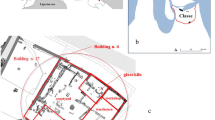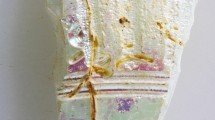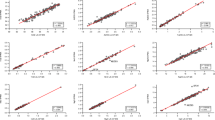Abstract
The research focused on a collection of 37 Late Antique glass fragments, found at the archaeological site of San Giusto (southern Italy). The analyses performed by SEM-EDS, EMPA and LA-ICP-MS showed that all samples are constituted by natron-based soda-lime silica glass and allowed clarifying the distinction between Egyptian HIMT1 and HIMT2 productions. The comparison with the composition of the available glass reference groups was verified through three ternary diagrams (provided here for the first time). The results grouped San Giusto samples into HIMT1 (7 samples), HIMT2 (8 samples) and Levantine (13, plus maybe other 3 samples) productions. A convincing provenance assignment was not feasible for six samples only. The isotopic analyses (87Sr/86Sr and 143Nd/144Nd), performed on a selected set of ten samples, provided further information both in terms of glass technology and provenance, as well as in terms of reference groups characterisation. Particularly, the results demonstrated that nine out of a total of ten samples were made using a limestone-bearing sand enriched with variable amount of marine shells and provided further evidence for the distinction of the HIMT1 and HIMT2 groups; the latter overlapping the Levantine field in the 87Sr/86Sr versus εNd binary diagram. From a technological point of view, the importance of separating the likely ‘fresh’ materials from those intentionally recycled or coloured was put into clear evidence, especially in relation to provenance assignments. Lastly, an interesting technological feature has been observed in sample no. 9, where the composition of the main body of the vessel turned out to be different from that of the handle. This result provided clear evidence of the fact that different glass batches could have been used for the different parts of a single vessel body.








Similar content being viewed by others
References
van Achterbergh E, Ryan CG, Jackson SE, Griffin WL (2001) Data reduction software for LA–ICP–MS. In: Sylvester P (ed) Laser-ablation–ICPMS in the Earth sciences: principles and applications. Mineralogical Association of Canada, Ottawa, pp 239–243
Angelini I, Artioli G, Bellintani P, Diella V, Gemmi M, Polla A, Rossi A (2004) Chemical analyses of Bronze Age glasses from Frattesina di Rovigo, Northern Italy. J Archaeol Sci 31:1175–1184
Artioli G, Angelini I (2013) Evolution of vitreous materials in Bronze Age Italy. In: K. Janssens (ed) Modern methods for analysing archaeological and historical glass, vol I, pp 355–368
Artioli G, Angelini I, Polla A (2008) Crystals and phase transitions in protohistoric glass materials. Phase Transit 81:233–252
Avanzinelli R, Boari E, Conticelli S, Francalanci L, Guarnieri L, Perini G, Petrone CM, Ulivi M, Tommasini S (2005) High precision Sr, Nd and Pb isotopic analyses using the new generations Thermal Ionization Mass Spectrometer ThermoFinnigan Triton-Ti. Periodico di Mineralogia 75:147–166
Banner JL (2004) Radiogenic isotopes: systematics and applications to earth surface processes and chemical stratigraphy. Earth-Sci Rev 65:141–194
Bernal Casasola D (2010) Iglesia, producción y comercio en el Mediterráneo tardoantiguo. De las ánforas a los talleres eclesiásticos. In: Menchelli S, Pasquinucci M, Santoro S, Guiducci G (eds) LRCW3, Late Roman coarse wares, cooking wares and amphorae in the Mediterranean. Archaology and archaeometry, Comparison between western and eastern Mediterranean, BAR Int. Ser. 2185 (I). Archaeopress, Oxford, pp 19–31
Blomme A, Elsen J, Brems D, Shortland A, Dotsika E, Degryse P (2016) Tracing the primary production location of core-formed glass vessels, Mediterranean Group I. J Archaeol Sci Rep 5:1–9
Brems D, Ganio M, Degryse P (2014) Chapter 3. The Sr-Nd isotopic fingerprint of sand raw materials. In: Degryse P (ed) Glass Making in the Greco-Roman World. Results of the ARCHGLASS Project. Leuven University Press, Leuven, pp 51–67
Brill RH (1988) Scientific investigations of the Jalame glass and related finds. In: Weinberg DG (ed) Excavations at Jalame: site of a glass factory in late Roman Palestine. University of Missouri Press, Columbia, p 378
Degryse P (ed) (2014) Glass making in the Greco-Roman world. Results of the ARCHGLASS Project. Leuven University Press, Leuven
Degryse P, Schneider J (2008) Pliny the Elder and Sr-Nd isotopes: tracing the provenance of raw materials for Roman glass production. J Archaeol Sci 35:1993–2000
Favia P, Giuliani R, Turchiano M (2015) La produzione in Italia meridionale fra Tardo Antico e Medioevo: indicatori archeologici, assetti materiali, relazioni-socio-economiche. In: Molinari A, Santangeli Valenzani R, Spera L (eds) L’archeologia della produzione a Roma (secoli V-XV), Atti del Convegno Internazionale di Studi. Edipuglia, Bari, pp 521–551
Foster HE, Jackson CM (2009) The composition of ‘naturally coloured’ late Roman vessel glass from Britain and the implications for models of glass production and supply. J Archaeol Sci 36:189–204
Foy D, Picon M, Vichy M, Thirion-Merle V (2003) Caractérisation des verres de la fin de l'Antiquité en Méditerranée occidentale: l'émergence de nouveaux courants commerciaux. In: Foy D, Nenna M-D (ed) Échanges et commerce du verre dans le monde antique, Actes du Colloque de l'AFAV, Aix-en-Provence et Marseille (7–9 Juin 2001), Monographies Instrumentum 24, edn. Monique Mergoil, pp 41–85
Freestone IC (1994) Chemical analysis of 'raw' glass fragments. In: Hurst H (ed) Excavations at Carthage, vol II. 1 The Circular Harbour, North Side, Oxford Univ Press for British Academy, Oxford, p 290
Freestone IC, Gorin-Rosen Y, Hughes MJ (2000) Primary glass from Israel and the production of glass in late Antiquity and the early Islamic period. In: Nenna M-D (ed) La route du verre. Ateliers primaires et secondaires du second millénaire av. J.-C. au Moyen Âge, Travaux de la Maison de l’Orient Méditerranéen. Maison de l’Orient Méditerranéen, Jean Pouilloux, Lyon, p 33
Freestone IC, Leslie KA, Thirlwall M, Gorin-Rosen Y (2003) Strontium isotopes in the investigation of early glass production: byzantine and early Islamic glass from the near east. Archaeometry 45:19–32
Freestone IC, Wolf S, Thirlwall M (2005) The production of HIMT glass: elemental and isotopic evidence, Proceedings of the 16th Congress of the Association Internationale pour l’Histoire du Verre, London, pp 153–157
Gallo F, Silvestri A, Molin G (2013) Glass from the Archaeological Museum of Adria (North-East Italy): new insights into Early Roman production technologies. J Archaeol Sci 40:2589–2605
Gallo F, Marcante A, Silvestri A, Molin G (2014) The glass of the “Casa delle Bestie Ferite”: a first systematic archaeometric study on Late Roman vessels from Aquileia. J Archaeol Sci 41:7–20
Gallo F, Silvestri A, Degryse P, Ganio M, Longinelli A, Molin G (2015) Roman and late-Roman glass from north-eastern Italy: the isotopic perspective to provenance its raw materials. J Archaeol Sci 62:55–65
Ganio M, Boyen S, Brems D, Scott R, Foy D, Latruwe K, Molin G, Silvestri A, Vanhaecke F, Degryse P (2012a) Trade routes across the Mediterranean: a Sr/Nd isotopic investigation on Roman colourless glass. Glass Technol Eur J Glass Sci Technol Part A 53:217–254
Ganio M, Boyen S, Fenn T, Scott R, Vanhoutte S, Gimeno D, Degryse P (2012b) Roman glass across the empire: an elemental and isotopic characterization. J Anal At Spectrom 27:743–753
Giannetti F (2011-2012) I vetri della Puglia centro-settentrionale: produzioni, tipologie, funzioni, circolazione e iconografie. MA dissertation, University of Foggia
Giannetti F, Gliozzo E, Turchiano M (2015) I vetri tardoantichi e altomedievali di Herdonia e Faragola. Produzione, funzioni e mercato. In: Arthur P, Leo Imperiale M (eds) VII Congresso Nazionale di Archeologia Medievale. All’insegna del Giglio, Firenze, pp 293–298
Giuliani R, Turchiano M (2003) I vetri della Puglia centro settentrionale tra tardoantico e alto medioevo. In: Piccioli C, Sogliani F (eds) Il vetro in Italia Meridionale ed Insulare, Atti del Primo Convegno Multidisciplinare IV Giornata Nazionale di Studio Comitato Nazionale AIHV. De Frede, Napoli, pp 139–159
Gliozzo E (2017) The composition of colourless glass: a review. Archaeol Anthropol Sci 9:455–483. doi:10.1007/s12520-016-0388-y
Gliozzo E, Fortina C, Memmi I, Turchiano M, Volpe G (2005) Cooking and painted ware from San Giusto (Lucera, Foggia): the production cycle, from the supply of raw materials to the commercialisation of products. Archaeometry 47:13–29
Gliozzo E, Leone D, Origlia F, Turbanti Memmi I, Volpe G (2010a) Archaeometric characterisation of coarse and painted fine ware from Posta Crusta (Foggia, Italy): technology and provenance. Archaeol Anthropol Sci 2:175–189
Gliozzo E, Santagostino Barbone A, D'Acapito F, Turchiano M, Memmi I, Volpe G (2010b) The sectilia panels of Faragola (Ascoli Satriano, southern Italy): a multi-analytical study of the green, marbled (green and yellow), blue and blackish glass slabs. Archaeometry 52:389–415
Gliozzo E, Santagostino Barbone A, Turchiano M, Memmi Turbanti I, Volpe G (2012) The coloured tesserae decorating the vaults of the Faragola’s balneum (Ascoli Satriano, Foggia, southern Italy). Archaeometry 54:311–331
Gliozzo E, Turchiano M, Lombardi M, Turbanti Memmi I, Volpe G, Baxter MJ (2013) North Apulian coarse wares and fine painted wares: a reappraisal according to new data from Herdonia and Canusium. Archaeometry 55:423–448
Gliozzo E, Scrima G, Turchiano M, Memmi I (2014) The Faragola ceramic collection: ceramic production, consumption and exchange in seventh-century Apulia. Archaeometry 56:961–986
Gliozzo E, Baldassarre G, Turchiano M, Memmi I (2016a) From the kilns to the fair: producing building materials at Faragola and Canusium (northern Apulia, Italy). Archaeol Anthropol Sci 8:705–729
Gliozzo E, Turchiano M, Giannetti F, Memmi I (2016b) Late Antique and Early Medieval glass vessels from Faragola (Italy). Archaeometry 58:113–147
Gliozzo E, Turchiano M, Giannetti F, Santagostino Barbone A (2016c) Late antique glass vessels and production indicators from the town of Herdonia (Foggia, Italy). New data on CaO-rich / weak HIMT glass. Archaeometry 58:81–112
Gratuze B (1988) Analyse non destructive d'objects en verre par des méthodes nucléaires. In: Application à l'etude des estampilles et poids monétaires islamiques. Nouvelle thése d'Université, Orléans
Henderson J, McLoughlin SD, McPhal DS (2004) Radical changes in Islamic glass technology: evidence for conservatism and experimentation with new glass recipes from early and middle Islamic Raqqa, Syria. Archaeometry 46:439–468
Huisman DJ, De Groot T, Pols S, Van Os BJH, Degryse P (2009) Compositional variation in roman colourless glass objects from the Bocholtz burial (The Netherlands). Archaeometry 51:413–439
Kamber BS, Greig A, Collerson KD (2005) A new estimate for the composition of weathered young upper continental crust from alluvial sediments, Queensland, Australia. Geochim Cosmochim Acta 69:1041–1058
Leslie KA, Freestone IC, Lowry D, Thirlwall M (2006) Provenance and technology of near Eastern glass: oxygen isotopes by laser fluorination as a compliment to Sr. Archaeometry 48:253–270
Maltoni S, Silvestri A, Marcante A, Molin G (2016) The transition from Roman to Late Antique glass: new insights from the Domus of Tito Macro in Aquileia (Italy). J Archaeol Sci 73:1–16
Martorelli R (1999) Riflessioni sulle attività produttive nell’età tardoantica ad altomedievale: esiste un artigianato «ecclesiastico» ? Riv Archeol Cristiana 75:571–596
Mirti P, Casoli A, Appolonia L (1993) Scientific analysis of Roman glass from Augusta Praetoria. Archaeometry 35:225–240
Paolucci F (1997) I vetri incisi dall’Italia settentrionale e dalla Rezia nel periodo medio e tardo imperiale. All’Insegna del Giglio, Firenze
Pouchou LJ, Pichoir F (1984) New model for quantitative x-ray microanalysis. Part I: application to the analysis of homogeneous samples. Rech Aerospatiale 3:13–38
Saguì L (1996) Un piatto di vetro inciso da Roma: contributo ad un inquadramento delle officine vetrarie tardoantiche. In: Picozzi MG, Carinci F (eds) Studi in memoria di Lucia Guerrini, Rome, pp 337–358
Saguì L (2002) Roma, i centri privilegiati e la lunga durata della tardoantichità. Dati archeologici dal deposito di VII secolo nell’esedra della Crypta Balbi. Archeol Mediev 29:7–42
Saguì L (2009) Ateliers de verre gravé à Rome au IVe siècle Ap. J.-C.: nuovelles données sur le verre gravé «à relief négatif». In: Degryse P, Cosyns P, Caen J, Van't dack L (eds) Annales du 17e Congrès de l’Association Internationale pour l’Histoire du Verre, pp 206–216
Santagostino Barbone A, Gliozzo E, Turchiano M, D'Acapito F, Memmi I, Volpe G (2008) The sectilia panels of Faragola (Ascoli Satriano, southern Italy): a multi-analytical study of the red, orange and yellow glass slabs. Archaeometry 50:451–473
Schibille N, Sterrett-Krause AE, Freestone IC (2016) Glass groups, glass supply and recycling in Late Roman Carthage. Archaeol Anthropol Sci. doi:10.1007/s12520-016-0316-1
Stevenson J (2001) The vessel glass. In: Mitchell J, Hansen IL (eds) San Vincenzo al Volturno 3: the finds from the 1980–1986 excavations. Centro italiano di Studi Sull'alto Medioevo, Spoleto, pp 203–277
Stille P, Shields G (1997) Radiogenic isotope geochemistry of sedimentary and aquatic systems, 68th edn. Springer, Berlin
Thirlwall MF (1991) Long-term reproducibility of multicollector Sr and Nd isotope ratio analysis. Chem Geol 94:85–104
Tiepolo M, Bottazzi P, Palenzona M, Vannucci R (2003) A laser probe coupled with ICP – double focusing sector-field mass spectrometer for in situ analysis of geological samples and U–Pb dating of zircon. Can Mineral 41:259–272
Turchiano M (2010) Le ceramiche comuni dell’Apulia tardoantica e altomedievale: luoghi della produzione, del commercio e del consumo. In: Menchelli S, Pasquinucci M, Santoro S, Guiducci G (eds) LRCW3, Late Roman coarse wares, cooking wares and amphorae in the Mediterranean. Archaeology and archaeometry, comparison between western and eastern Mediterranean, BAR Int. Ser. (II). Archaeopress, Oxford, pp 657–668
Uboldi M (1995) Diffusione delle lampade vitree in età tardoantica e altomedievale e spunti per una tipologia. Archeol Mediev 22:93–145
Uboldi M (1999) I vetri. In: Brogiolo GP (ed) S. Giulia di Brescia: gli scavi dal 1980 al 1992. Reperti preromani, romani e altomedievali. All'Insegna del Giglio, Firenze, pp 271–307
Vaggelli G, Olmi F, Conticelli S (1999) Quantitative electron microprobe analysis of reference silicate mineral and glass samples. Acta Vulcanol 11:297–303
Volpe G (ed) (1998) San Giusto. La villa, le ecclesiae. Primi risultati dagli scavi nel sito rurale di San Giusto (Lucera): 1995–1997. Edipuglia, Bari
Volpe G (2001) Linee di storia del paesaggio dell’Apulia romana: San Giusto e la valle del Celone. In: Lo Cascio E, Storchi Marino A (eds) Modalità insediative e strutture agrarie nell’Italia meridionale in età romana, Atti del Convegno Internazionale. Edipuglia, Bari, pp 315–361
Volpe G (2002) Il mattone di Iohannis. San Giusto (Lucera, Puglia). In: Carrié JM, Lizzi Testa R (eds) “Humana sapit”. Études d’Antiquité tardive offertes à Lellia Cracco Ruggini, Bibliotèque d’Antiquité Tardive 3. Brepols, Turnhout, pp 79–93
Volpe G (2007) Il ruolo dei vescovi nei processi di trasformazione del paesaggio urbano e rurale. In: Brogiolo GP, Chavarría Arnau A (eds) Archeologia e società tra Tardo Antico e Alto Medioevo, Atti del 12° Seminario sul Tardo Antico e l’Alto Medioevo. SAP, Mantova, pp 85–106
Volpe G (2012) Per una geografia insediativa ed economica della Puglia tardoantica, Bizantini, Longobardi e Arabi in Puglia nell’Alto Medioevo, Atti del XX Congresso Internazionale di studio sull’alto medioevo. Fondazione Centro Italiano di Studi sull’Alto Medioevo, Spoleto, pp 27–56
Volpe G, Annese C, Favia P (2007) Terme e complessi religiosi paleocristiani: il caso di San Giusto. In: Martin J-M, Beauvois MG (eds) Bains curatifs et bains hygiéniques en Italie de l’Antiquité au Moyen Age. École française de Rome, Roma, pp 217–261
Volpe G, Romano AV, Turchiano M (2013) San Giusto, l’ecclesia e il Saltus Carminianensis: vescovi rurali, insediamenti, produzioni agricole e artigianali. Un approccio globale allo studio della cristianizzazione delle campagne. In: Cresci S, Lopez Quiroga J, Brandt O, Pappalardo C (eds) Episcopus, civitas territorium, Atti del XV Congresso Internazionale di Archeologia Cristiana. Studi di Antichità Cristiane LXV, Città del Vaticano, pp 559–580
Volpe G, Buglione A, De Venuto G (2015a) Lane, pecore e pastori in Puglia tra Tardoantico e Medioevo: novità dai dati archeozoologici. In: Busana MS, Basso P (eds) La lana nella Cisaplina romana, economia e società. Studi in onore di Stefania Pesavento Mattioli, Padova University Press, Padova, pp 243–268
Volpe G, Leone D, Spanu PG, Turchiano M (2015b) Produzione, merci e scambi tra isole e terraferma nel Mediterraneo occidentale tardoantico. In: Martorelli R, Piras A, Spanu PG (eds) Isole e terraferma nel primo Cristianesimo. Identità locale ed interscambi culturali, religiosi e produttivi, Atti XI Convegno Nazionale di Archelogia Cristiana. PFTS University Press, Cagliari, pp 417–440
Author information
Authors and Affiliations
Corresponding author
Electronic supplementary material
Supplementary Table 1
(DOCX 14 kb)
Supplementary Table 2
(DOCX 13 kb)
Rights and permissions
About this article
Cite this article
Gliozzo, E., Braschi, E., Giannetti, F. et al. New geochemical and isotopic insights into the Late Antique Apulian glass and the HIMT1 and HIMT2 glass productions—the glass vessels from San Giusto (Foggia, Italy) and the diagrams for provenance studies. Archaeol Anthropol Sci 11, 141–170 (2019). https://doi.org/10.1007/s12520-017-0531-4
Received:
Accepted:
Published:
Issue Date:
DOI: https://doi.org/10.1007/s12520-017-0531-4




